

 |
 |
 |
 |
 |
 |
Currently Taking Residence in the Freebie Box:
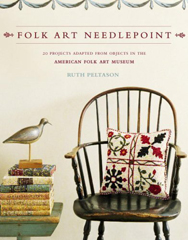 Folk Art Needlepoint: 20 Projects Adapted from Objects in the American Folk Art Museum
Folk Art Needlepoint: 20 Projects Adapted from Objects in the American Folk Art Museum
by Ruth Peltason
This is a beautiful (if expensive) book of 20 needlepoint projects that are all adapted from actual items on display at the American Folk Art Museum in New York. Some of the projects are complete recreations, some just use motifs and color schemes from other museum pieces such as furniture, quilts, and weathervanes. Ruth Peltason did a great job in finding inspiration in the old and translating it into the new. The book has a short technique section at the back, and discussions of the original pieces. Now, how useful will this book be for AntiCrafters? If you're into embroidery, you'll definitely want to at least peruse it at the library, but unless you're looking for nature-based motifs (it's full of flowers, trees, and animals), you'll probably not have much use for it.
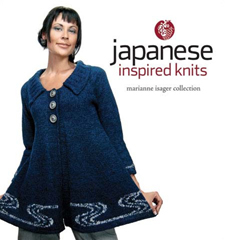 Japanese Inspired Knits
Japanese Inspired Knits
by Marianne Isager
Did you ever have to sit through an art class where you were shown slide after slide of an artist's work whose style you were just not into? It might have been good, it might have been bad, but it just didn't speak to you? And was the artist there to explain the motivation behind each piece? Did you sit there at first thinking, "Oh good, with an explanation I might be able to see what the artist saw and come to appreciate this body of work," only to find yourself 10 slides in thinking instead, "You got WHAT from WHERE? Are you SURE? You know this is still ugly, right? And not ugly in an interesting or challenging way, either. Just... ugly!"
Yeah, that was this book for me. Blech.
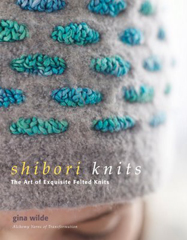 Shibori Knits: The Art of Exquisite Felted Knits
Shibori Knits: The Art of Exquisite Felted Knits
by Gina Wilde
I find the concept of shibori knitting fascinating. I was first introduced to shibori by Raellyn, who was still a Fine Arts undergrad at the time. (Yes, we have known each other for.ev.er.) We used shibori techniques to dye some cloth napkins, which are still in use around AC HQ. To dye shibori-style, you restrict the dye's access to the fabric by folding and tying it with string, leaving areas of the fabric undyed. To knit shibori-style, you felt your finished object but tie off areas of it with some kind of support so that they won't felt, or purposely use a non-felting fiber in certain places so that they will remain unfelted. Here's my problem: as visually interesting as many knitted shibori pieces are, they are generally not things I would ever wear because they look... well, diseased. Which is awesome in its own way, as a wall hanging or sculptural piece, but not something I am into unless it's Knit Like A Zombie night. And let's face it, that only comes once a year, so how much diseased knitting can I need? So while I'd recommend this book for someone wanting to read about the process of shibori knitting, I wouldn't ever recommend any of the projects in it unless the word "pustule" had already come up, favorably, in conversation.
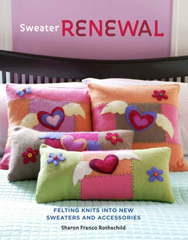 Sweater Renewal: Felting Knits into New Sweaters and Accessories
Sweater Renewal: Felting Knits into New Sweaters and Accessories
by Sharon Franco Rothschild
Ok, so this book starts with knitted items (which I like) and felts them (which I like) and then sews them (which I don't like, but I know a lot of you do) into new objects and then proceeds to embellish the crap out of them (which I hate) until they are Lisa Frank-esque mockeries of their former selves. Let me save you $19.95: Find wool sweaters in thrift stores. Wash them in hot water and dry them in the dryer. Now cut them apart into pieces of fabric. Take any pattern you've ever sewn that requires a semi-sturdy fabric and use the newly felted pieces instead of buying new fabric. Voila! And here's your free gift with purchase: Pillows are any two same-shaped pieces of fabric sewn together all around and stuffed with something. But wait, there's more! Bags are any two same-shaped pieces of fabric sewn together on only three sides with a strap added. There's your thrifty craft hint for the day. You're welcome.
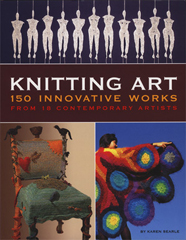 Knitting Art: 150 Innovative Works from 18 Contemporary Artists
Knitting Art: 150 Innovative Works from 18 Contemporary Artists
by Karen Searle
This is another beautiful (if expensive) coffee table book, filled with gorgeous photographs of some truly artistic uses of knitting. The pieces range from haute couture to sculpture to political graffiti. It's a wonderful gathering of some of the best knitting I've ever seen in one place. (Lindsey Obermyer and Ana Maltz? Why couldn't I have been you?) If you are into knitting you need to spend an evening curled up with this book. Period. There will be things in it you don't like, but I can practically guarantee that there will be at least one thing that makes your creative urges flutter like the thighs of a Japanese school girl who just dropped her books in the hallway in front of her crush. Go find a copy, now!
home • antifesto • this issue • archive • submit • errata • masthead • contact us • legal